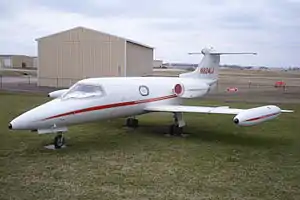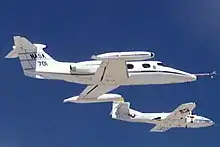Learjet 23
The Learjet 23 (originally Lear Jet 23) is an American six-to-eight-seat (two crew and four to six passengers) twinjet, high-speed business jet manufactured by Learjet. Introduced in 1964, it was Learjet's first model and created a new market for fast and efficient small business aircraft. Production ended in 1966 after 101 aircraft had been delivered.
| Learjet 23 | |
|---|---|
 | |
| Role | Business jet |
| Manufacturer | Learjet |
| Designer | William Powell Lear, based on a design by Dr.eng. Hans-Luzius Studer |
| First flight | 7 October 1963 |
| Introduction | 13 October 1964 |
| Retired | 31 December 2015 (became non-compliant with FAR 91) |
| Status | Inactive |
| Produced | 1964-1966[1] |
| Number built | 101[1] |
Development
Recognizing the potential of the Swiss-designed single-engine ground-attack FFA P-16 fighter jet, William (Bill) Powell Lear, Sr. established Swiss American Aviation Corporation (SAAC) to produce a two-engined passenger version: the SAAC-23 Execujet. The company moved to Wichita, Kansas and was renamed Lear Jet Corporation. Production began on the first Model 23 Lear Jet on February 7, 1962. The first flight took place on 7 October 1963 with test pilots Hank Beaird and Bob Hagen.[2] On 4 June 1964, the prototype crashed soon after takeoff, when the pilot inadvertently deployed the wing spoilers while demonstrating an engine failure on takeoff.[3] Eventually determined to be pilot error, this mishap did not deter the Federal Aviation Agency (later the Federal Aviation Administration) from awarding the Lear Jet 23 its type certificate on 31 July 1964. On October 13, 1964, the first production aircraft was delivered.
Production ended in 1966 after one hundred and one aircraft had been delivered. In 1998, thirty nine Model 23s were estimated to remain in use. Twenty seven are known to have been lost or damaged beyond repair through accidents, the most recent being in 2008.[4]
Noise compliance
In 2013, the FAA modified the FAR Part 91 rules to prohibit the operation of jets weighing 75,000 pounds or less that are not Stage 3 noise compliant beyond December 31, 2015, with the Lear Jet 23 listed in the Federal Register 78 FR 39576. This meant that any Lear Jet 23's without modified Stage 3 noise-compliant engines - or an approved hushkit - were no longer permitted to fly in the contiguous 48 states after that date. The ruling noted that appropriate hushkits were not currently available for the Lear Jet 23.
Aircraft on display

- N802L – Model 23 on static display at the Udvar-Hazy Center of the National Air and Space Museum in Chantilly, Virginia.[5][6]
- N505PF – Model 23 on static display at the Kansas Aviation Museum in Wichita, Kansas.[7][6]
- N20EP – on display outside White Industries, Bates City, Missouri.
- N23BY – Model 23 on display at the Arkansas Air & Military Museum in Fayetteville, Arkansas. This airframe was flown by Bobby Younkin in air shows.[8][9]
- N154AG – Model 23 on static display at the Museum of Flight in Seattle, Washington.[10]
- N73CE – Model 23 in storage at the Yanks Air Museum in Chino, California.[11]
- N824LJ – Model 23 on static display at the Air Zoo in Portage, Michigan.[12]
- N88B – Model 23 on static display at the Pima Air and Space Museum in Tucson, Arizona.[13]
Specifications
Data from Jane's All The World's Aircraft 1965–66[14]
General characteristics
- Crew: Two pilots
- Capacity: 6 passengers
- Length: 43 ft 3 in (13.18 m)
- Wingspan: 35 ft 7 in (10.84 m)
- Height: 12 ft 7 in (3.84 m)
- Wing area: 231.2 sq ft (21.48 m2)
- Empty weight: 6,150 lb (2,790 kg)
- Max takeoff weight: 12,499 lb (5,669 kg)
- Powerplant: 2 × General Electric CJ610-4 turbojet engines, 2,850 lbf (12.7 kN) thrust each
Performance
- Maximum speed: 561 mph (903 km/h, 487 kn) at 24,000 ft (7,300 m)
- Maximum speed: Mach 0.82
- Cruise speed: 518 mph (834 km/h, 450 kn) at 40,000 ft (12,000 m)
- Stall speed: 104 mph (167 km/h, 90 kn) wheels and flaps down
- Range: 1,830 mi (2,950 km, 1,590 nmi) max fuel at 485 mph (781 km/h; 421 kn) and 40,000 ft (12,000 m)
- Service ceiling: 45,000 ft (14,000 m)
- Rate of climb: 6,900 ft/min (35 m/s)
References
- Murdo Morrison (12 October 2018). "NBAA: Business jet designs that changed the industry". FlightGlobal.
- "Lear Celebrates 30". Flying. Vol. 120 no. 12. December 1993. p. 38. ISSN 0015-4806.
- "ASN Aircraft Accident Learjet 23". Flight Safety Foundation. Retrieved 7 October 2020.
- Aviation Safety Network: Learjet 23
- "Lear Jet 23". Smithsonian National Air and Space Museum. Smithsonian Institution. 18 March 2016. Retrieved 8 November 2016.
- "Learjet 23/24 production list". rzjets. rzjets.net. Retrieved 8 November 2016.
- "Learjet Model 23". Kansas Aviation Museum. 11 June 2014. Retrieved 8 November 2016.
- Mathews, Kay (4 February 2011). "Since 1986 aviation history flies high at the Arkansas Air Museum". Digital Journal. digitaljournal.com. Retrieved 8 November 2016.
- "Aircraft N23BY Data". Airport-Data.com. Airport-Data.com. Retrieved 8 November 2016.
- "Learjet 23". The Museum of Flight. The Museum Of Flight. Retrieved 8 November 2016.
- "Airframe Dossier - Swiss American Aviation CorporationLearjet, c/n 23-068, c/r N73CE". Aerial Visuals. AerialVisuals.ca. Retrieved 8 November 2016.
- "Airframe Dossier - Swiss American Aviation Corporation 23 Lear Jet, c/n 23-083, c/r N824LJ". Aerial Visuals. AerialVisuals.ca. Retrieved 30 July 2018.
- "Learjet 23". Pima Air and Space Museum. Pima Air and Space Museum. Retrieved 20 December 2019.
- Taylor 1965, pp. 252–253.
- Ogden, Bob, "Aviation Museums and Collections of North America", 2007, Air-Britain (Historians) Ltd, ISBN 0-85130-385-4.
- Taylor, John W. R. Jane's All The World's Aircraft 1965–1966. London:Sampson Low, Marston & Company, 1965.
- Specs of the Learjet Model 23
- Learjet timeline from Wings of Kansas
External links
| Wikimedia Commons has media related to Learjet 23. |
